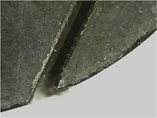Using the functional approach in the development of hybrid processes in engineering: practical aspects
DOI:
https://doi.org/10.20535/2521-1943.2022.6.3.269900Keywords:
hybrid tool, functional approach, processing of composites, laser processing, jet-laser cutting, cryogenic ice generationAbstract
The principles of creating hybrid processing processes based on the functional approach are given. The base of this approach, its theoretical aspects are given in the first part of the article. The practical application of the approaches is reflected in specific scientific and technical problems in the problem of high-quality cleaning of the surface from various adhesive coatings, the use of methods for obtaining holes and perforations in workpieces from metals and composite materials, as well as in the problem of contour cutting of plates from super hard sintered materials. It is shown that the use of a functionally oriented approach makes it possible to identify such combinations of force and energy effects that make it possible to process even those materials that are considered difficult to process or not machinable.
The combination of actions that are heterogeneous in nature into one instrumental effect also allows for a new way of shaping the performed holes. At the same time, the properties of the workpiece have a much smaller effect on the parameters of the obtained surfaces than with traditional processing
Samples of cleaned surfaces, cuts of super hard materials, holes in honeycomb systems of aerospace engineering are presented.
References
- Ye. I. Golibardov, A. V. Kudryavtsev and M. I. Sinenko, Tekhnika FSA. Kyiv: Tekhnika, 1989, 239 p.
- B. M. Bazrov, Sovershenstvovaniye proizvodstva detaley na osnove modul'noy tekhnologii. Moskva: Informpribor, 1989, 52 p.
- V. S. Ivanova, A. S. Balankin, I. J. Bunin and A. A. Oksogoev, Synergetics and fractals in material science. Мoscow: Nauka, 1994, 383 p.
- O. F. Salenko, I. V. Petko and O. V. Tretyakov, Hidro- ta hidroabrazyvna obrobka: teoriya, tekhnolohiya ta obladnannya. Kyiv: IZMN, 1999, 488 p.
- M. Hashish, “Steel Cutting with Abrasive Waterjets", in Proceedings of the 6th International Symposium on Jet Cutting Technology, Surrey, England, 1982, pp. 465–487.
- S. A. Klimenko, Yu. A. Mel’niichuk and G. V. Vstovskii, “Interrelation between the Structure Parameters, Mechanical Properties of Sprayed Materials, and the Tool Life in Cutting Them”, J. of Superhard Mat., vol. 30, no. 2, pp. 115–121, 2008. DOI: https://doi.org/10.3103/S1063457608020068.
- P. D. Gindin, “Mathematical model of thermocracking of anisotropic brittle materials”, Journal of Surface Investigation. X-ray, Synchrotron and Neutron Techniques, vol. 4, no. 1, pp. 22–24, 2010. DOI: https://doi.org/10.1134/S1027451010010040.
- O. Salenko, G. Gabuzyan, Y. Myronov and V. Nikitin, “About some results of processing SiC-microarrays by hydroabrasive precision jet“, Journal of Mechanical Engineering NTUU "Kyiv Polytechnic Institute", no. 67, pp. 174-179, 2013. Available: https://journal.mmi.kpi.ua/old/article/view/37833.
- I. L. Povkh, Tekhnicheskaya gidromekhanika. Leningrad: Mashinostroyeniye, 1976, 504 p.
- M. Burnashov, A. Prezhbilov and Yu. Vasilenko, “Simulating of the process of destructing cover by water-ice jet when cleaning machine components”, Bulletin of the South Ural State University, series "Mechanical Engineering”, vol. 17, no 2. pp. 67–73, 2017. DOI: https://doi.org/10.14529/engin170208.
- W. Schulz, M. Nießen, U. Eppelt and K. Kowalick, “Simulation of Laser Cutting”, in The Theory of Laser Materials Processing: Heat and Mass Transfer in Modern Technology, vol. 119. Dordrecht: Springer Netherlands, 2009, pp. 21–69. DOI: https://doi.org/10.1007/978-1-4020-9340-1_2.
- A. F. Salenko, V. T. Shchetinin and A. N. Fedotyev, “Improving accuracy of profile hydro-abrasive cutting of plates of hardmetals and superhard materials”, J. of Superhard Mat., vol. 36, no. 3, pp. 199–207, 2014. DOI: https://doi.org/10.3103/S1063457614030083.
- M. Hashish, “Three-dimensional machining with abrasive-waterjets”, in Jet Cutting Technology, vol. 13. Dordrecht: Springer Netherlands, 1992, pp. 605–620. DOI: https://doi.org/10.1007/978-94-011-2678-6_40.
- V. Yu. Kholodnyy and A. F. Salenko, “The water jet guided laser method in punching honeycomb cores for Aerospace sandwich panels”, Eastern-European Journal of Enterprise Technologies, vol. 1, no. 5(79), pp. 19–30, 2016. DOI: https://doi.org/10.15587/1729-4061.2016.59870.
- O. Salenko, V. Schetinin and L. Fomovskaya, Jets methods of cutting carbide and super hard materials. LAP Lambert Academic Publishing, 2014, 116 p.
- V. Tkachuk, V. Shchetynin, S. Shlyk, O. Chencheva and O. Salenko, “The hybrid action tool for operations of cleaning of turbine units cavities”, Mechanics and Advanced Tecnologies, no. 2(89), pp. 79–90, 2020. DOI: https://doi.org/10.20535/2521-1943.2020.89.205168.
- A. F. Salenko, V. T. Shchetinin, A. N. Fedotiev, V. A. Dudyuk, S. A. Klimenko, A. I. Borimsky and T. A. Sorochenko, “Methods of cutting for workpieces of hardmetal and cBN-based polycrystalline superhard material”, J. of Superhard Mat., vol. 37, no. 4, pp. 271-281, 2015. DOI: https://doi.org/10.3103/S1063457615040073.
- O. Salenko, S. Klymenko, V. Orel, V. Kholodny and N. Gavrushkevich, “Using the functional approach in the development of hybrid processes in engineering: theoretical base”, Mech. Adv. Technol., vol. 6, no. 1, pp. 41–55, May 2022. DOI: https://doi.org/10.20535/2521-1943.2022.6.1.260938.

Downloads
Published
How to Cite
Issue
Section
License
Copyright (c) 2022 Олександр Саленко, Сергій Клименко, Вадим Орел, Володимир Холодний, Наталя Гаврушкевич

This work is licensed under a Creative Commons Attribution 4.0 International License.
Authors who publish with this journal agree to the following terms:
- Authors retain copyright and grant the journal right of first publication with the work simultaneously licensed under CC BY 4.0 that allows others to share the work with an acknowledgement of the work's authorship and initial publication in this journal.
- Authors are able to enter into separate, additional contractual arrangements for the non-exclusive distribution of the journal's published version of the work (e.g., post it to an institutional repository or publish it in a book), with an acknowledgement of its initial publication in this journal.
- Authors are permitted and encouraged to post their work online (e.g., in institutional repositories or on their website) prior to and during the submission process, as it can lead to productive exchanges, as well as earlier and greater citation of published work










